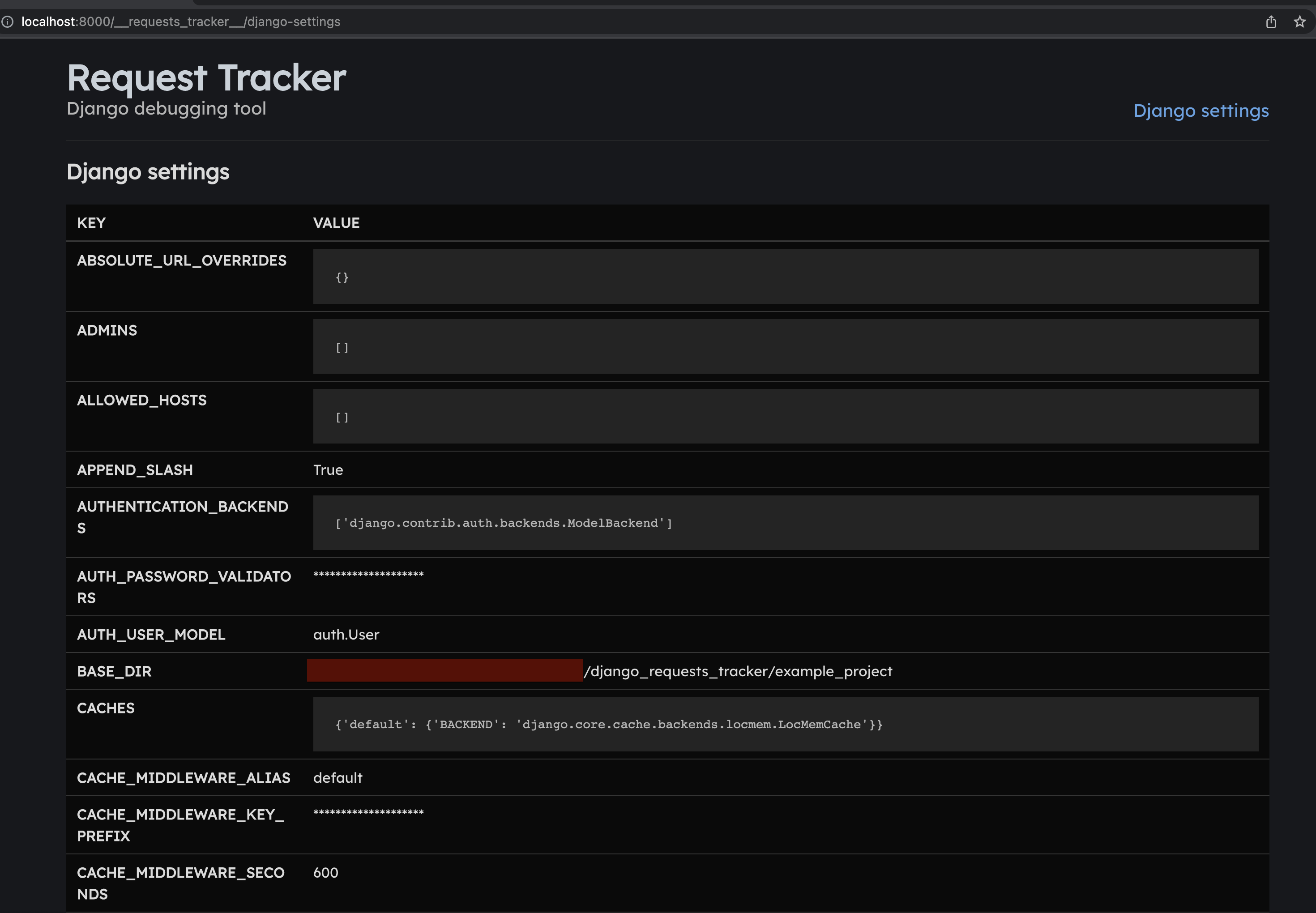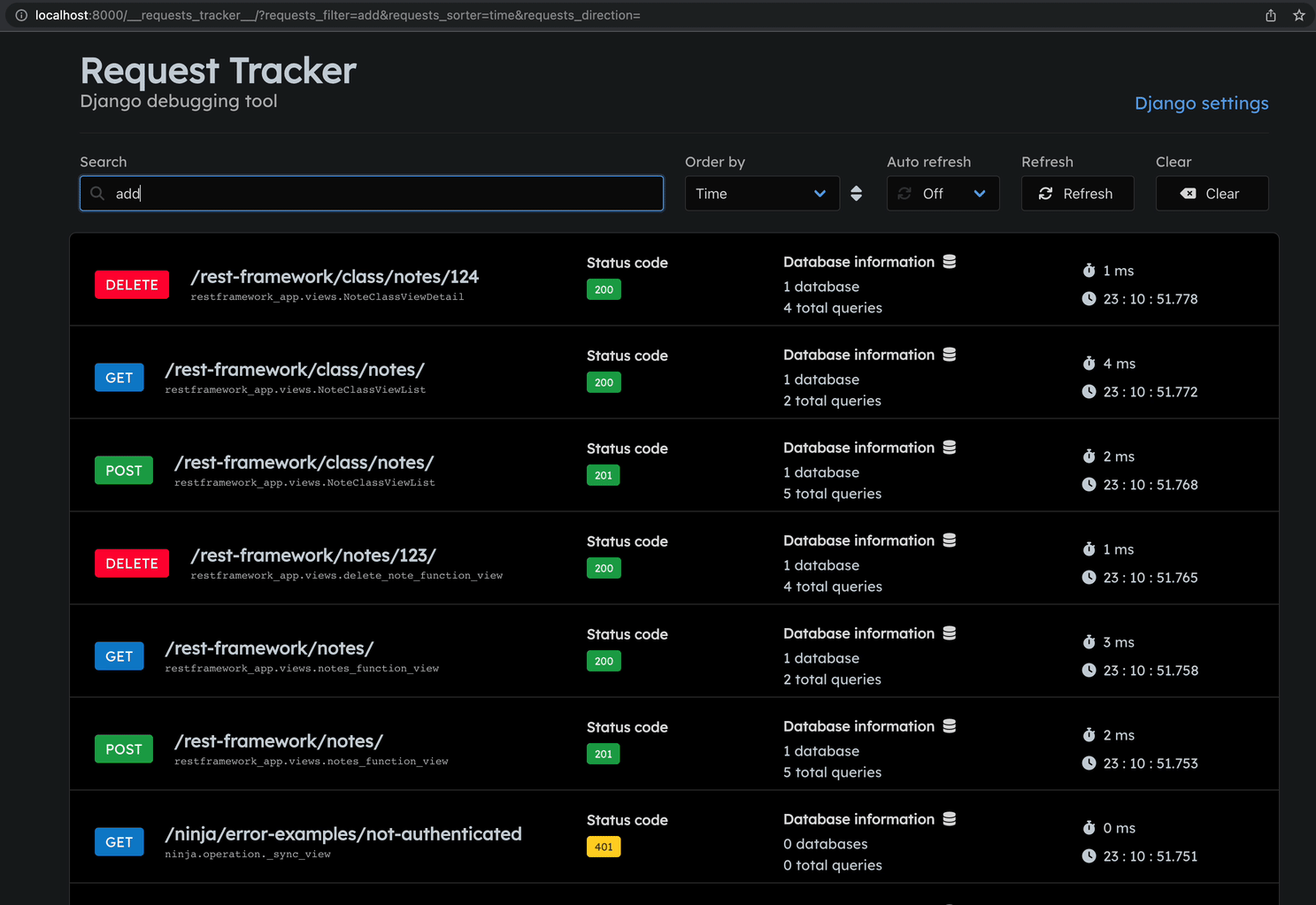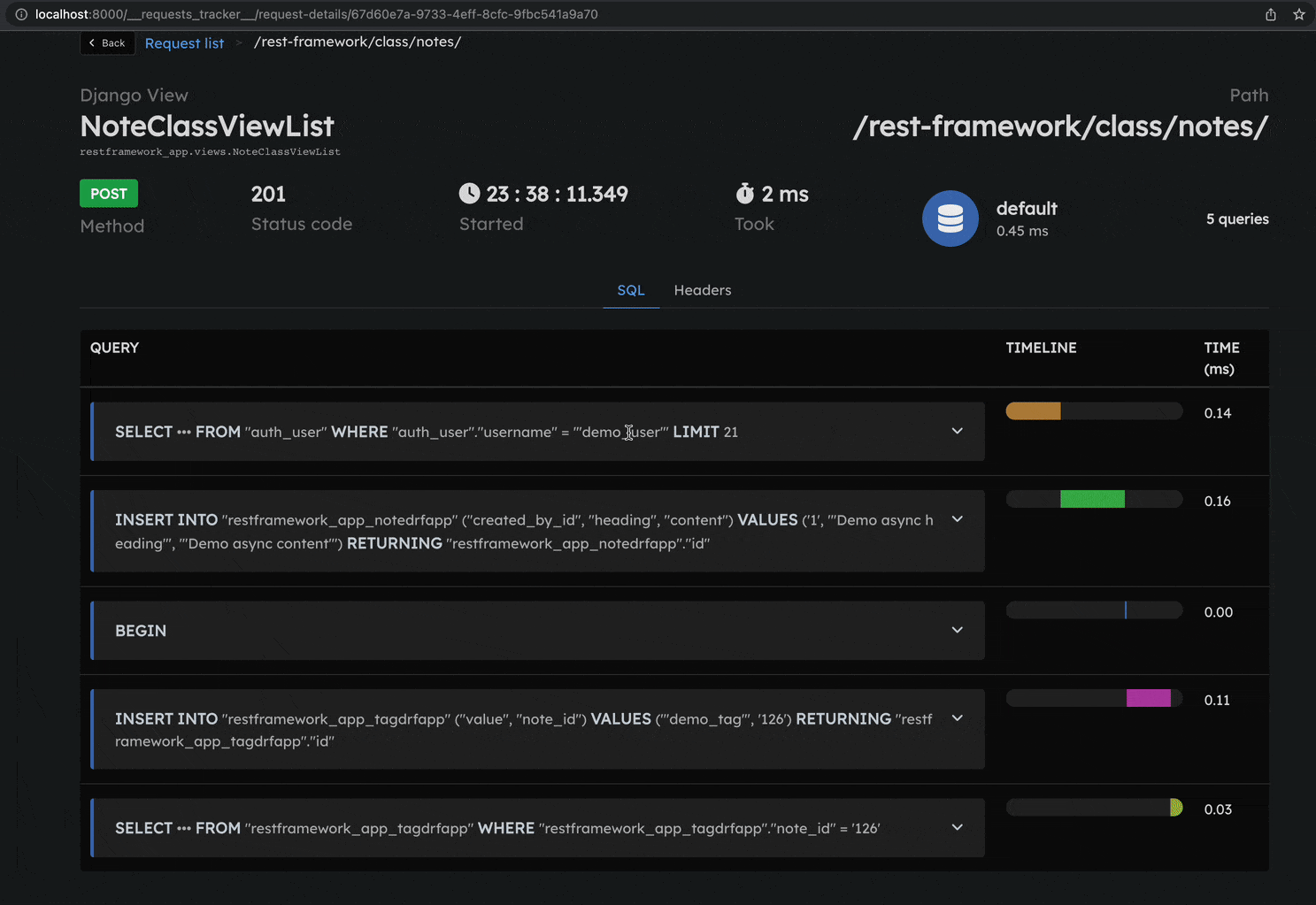The Django Requests Tracker is designed for local Django development, particularly for Rest API development. It provides various debugging information, such as SQL queries, headers, and status codes.
Project description
Django Requests Tracker
A convenient Django development tool based on the great Django Debug Toolbar but aimed towards rest API development. It collects and displays information on requests, responses, SQL queries, headers, Django settings and more.
Table of contents
Features
Requests list
Django Requests Tracker registers every request sent to your Django application and displays them in a tidy list. Each element in the list contains information about the request's HTTP method, path, Django view, status code, database information and query count and execution time and duration.
The requests list can be:
- Searched by path, Django view, sql and headers. The search is quite simple and a request is only filtered from the list if the search term does not exist in any of theses elements.
- Ordered in ascending and descending order by time, duration, Django view, query count, similar query count and duplicate query count.
- Auto-refreshed so that new requests will automatically show up in the list.
- Manually refreshed.
- Cleared.
The requests list in action 🎥
Request details
Each list element can be clicked where further information collected about the request such as SQL queries and headers can be found.
SQL queries
In request details, every SQL query executed in the context of the Django request should be shown, along with the execution time and a timeline bar that shows how big a chunk of the total time belongs to the given query. A stacktrace is shown for each query that helps with finding the origin of it.
Some queries are labelled with a tag X similar queries or X duplicate queries this can often indicate a problem and can be very handy when debugging or in development.
Similar Queriesmeans that the same query is executed more than once but with different parameters. This can for example happen when iterating over a list of IDs and fetching one item by ID at a time.Duplicate Queriesmeans that the exact same query with the same parameters is executed more than once. This can for example happen when iterating over a list child items and fetching same parent multiple times. Also known as an N-plus-1 query which is quite common problem with ORMs.
The request details view in action 🎥
Django Settings
Django settings very often contain some logic, and usage of environment variables and can even be spread out over multiple files. So it can be very beneficial to be able to see the current computed settings being used in the running process. Django Requests Tracker offers a simple way to view this. The view can be accessed by clicking on Django settings in the right corner of the requests tracker view.
All information determined to be sensitive, such as keys and passwords, are masked in the displayed settings.

The Example Project
This repository includes an example project to try out the package and see how it works. It can also be a great reference when adding the package to your project. To try it out, clone this project and follow the instructions on the example project README
Installation
If any of the following steps are unclear, check out the Example Project for reference.
Install the package
pip install requests-tracker
or install with you're chosen package tool, e.g. poetry, pipenv, etc.
Configure project settings
Settings prerequisites
First, ensure that django.contrib.staticfiles is in your INSTALLED_APPS setting and configured properly:
INSTALLED_APPS = [
# ...
"django.contrib.staticfiles",
# ...
]
STATIC_URL = "static/"
Second, ensure that your TEMPLATES setting contains a DjangoTemplates backend whose APP_DIRS options is set to True:
TEMPLATES = [
{
"BACKEND": "django.template.backends.django.DjangoTemplates",
"APP_DIRS": True,
# ...
}
]
Install the app, add middleware and configure internal ips
- Add
requests_trackerto yourINSTALLED_APPSsetting. - Add
requests_tracker.middleware.requests_tracker_middlewareto yourMIDDLEWAREsetting. - Add your internal IP addresses to
INTERNAL_IPSsetting.
if DEBUG:
INSTALLED_APPS += ["requests_tracker"]
MIDDLEWARE += ["requests_tracker.middleware.requests_tracker_middleware"]
INTERNAL_IPS = ["127.0.0.1"]
⚠️ If using Docker the following will set your INTERNAL_IPS correctly in Debug mode:
if DEBUG:
import socket # only if you haven't already imported this
hostname, _, ips = socket.gethostbyname_ex(socket.gethostname())
INTERNAL_IPS = [ip[: ip.rfind(".")] + ".1" for ip in ips] + ["127.0.0.1", "10.0.2.2"]
🚨 ️ It's recommended to only configure these settings in DEBUG mode. Even though Django Requests Tracker will only track requests in DEBUG mode it's still a good practice to only have it installed in DEBUG mode.
Configure URLs
Add Django Requests Tracker URLs to your project's URLconf:
if settings.DEBUG:
urlpatterns += [path("__requests_tracker__/", include("requests_tracker.urls"))]
🚨️ Again it's recommended to only add the URLs in DEBUG mode.
Optional: Configure static content for WSGI and ASGI servers, e.g. Uvicorn for async Django
Add static root to settings
# 🚨 Your project might not include BASE_DIR setting but likely some variation of it 🚨
BASE_DIR = Path(__file__).resolve().parent.parent
STATIC_ROOT = os.path.join(BASE_DIR, "static")
Add static root URLs to your project's URLconf:
urlpatterns += static(settings.STATIC_URL, document_root=settings.STATIC_ROOT)
Collect static files
python manage.py collectstatic
Configuration
Django Requests Tracker provides a few very simple settings. The settings are applied by setting REQUESTS_TRACKER_CONFIG setting in your settings.py file. REQUESTS_TRACKER_CONFIG takes a dictonary. Example:
# settings.py
REQUESTS_TRACKER_CONFIG = {
"IGNORE_PATHS_PATTERNS": (".*/api/keep-alive.*",),
"ENABLE_STACKTRACES": False",
}
IGNORE_SQL_PATTERNS
Takes a tuple of strings. Each string is a regular expression pattern. If a SQL query matches any of the patterns it will be ignored and not shown in the requests list or request details.
Default: ()
Example:
REQUESTS_TRACKER_CONFIG = {
"IGNORE_SQL_PATTERNS": (
r"^SELECT .* FROM django_migrations WHERE app = 'requests_tracker'",
r"^SELECT .* FROM django_migrations WHERE app = 'auth'",
),
}
IGNORE_PATHS_PATTERNS
Takes a tuple of strings. Each string is a regular expression pattern. If a request path matches any of the patterns it will be ignored and not tracked.
Default: ()
Example:
REQUESTS_TRACKER_CONFIG = {
"IGNORE_PATHS_PATTERNS": (
r".*/api/keep-alive.*",
),
}
SQL_WARNING_THRESHOLD
Represents the threshold in milliseconds after which a SQL query is considered slow and will be marked with a warning label in the SQL list.
Default: 500 (500 milliseconds)
Example:
REQUESTS_TRACKER_CONFIG = {
"SQL_WARNING_THRESHOLD": 50,
}
ENABLE_STACKTRACES
If set to False stacktraces will not be shown in the request details view.
Default: True
HIDE_IN_STACKTRACES
Takes a tuple of strings. Each string represents a module name. If a module name is found in a stacktrace that part of the stacktrace will be hidden.
Default:
(
"socketserver",
"threading",
"wsgiref",
"requests_tracker",
"django.db",
"django.core.handlers",
"django.core.servers",
"django.utils.decorators",
"django.utils.deprecation",
"django.utils.functional",
)
TRACK_SQL
If set to False SQL queries will not be tracked.
Default: True
Project details
Download files
Download the file for your platform. If you're not sure which to choose, learn more about installing packages.
Source Distribution
Built Distribution
Hashes for requests_tracker-0.3.3-py3-none-any.whl
| Algorithm | Hash digest | |
|---|---|---|
| SHA256 | 31d8924470ceea34be51743142c5248f1bf625d2ff95d1f0dccc2cfe14ecda0b |
|
| MD5 | 0e252e489be16c4fa81d3abb60737de7 |
|
| BLAKE2b-256 | 16f5d2fd9443c1839edf0c17216e9ab03201c16468e82e2968504fc738cd6917 |

















